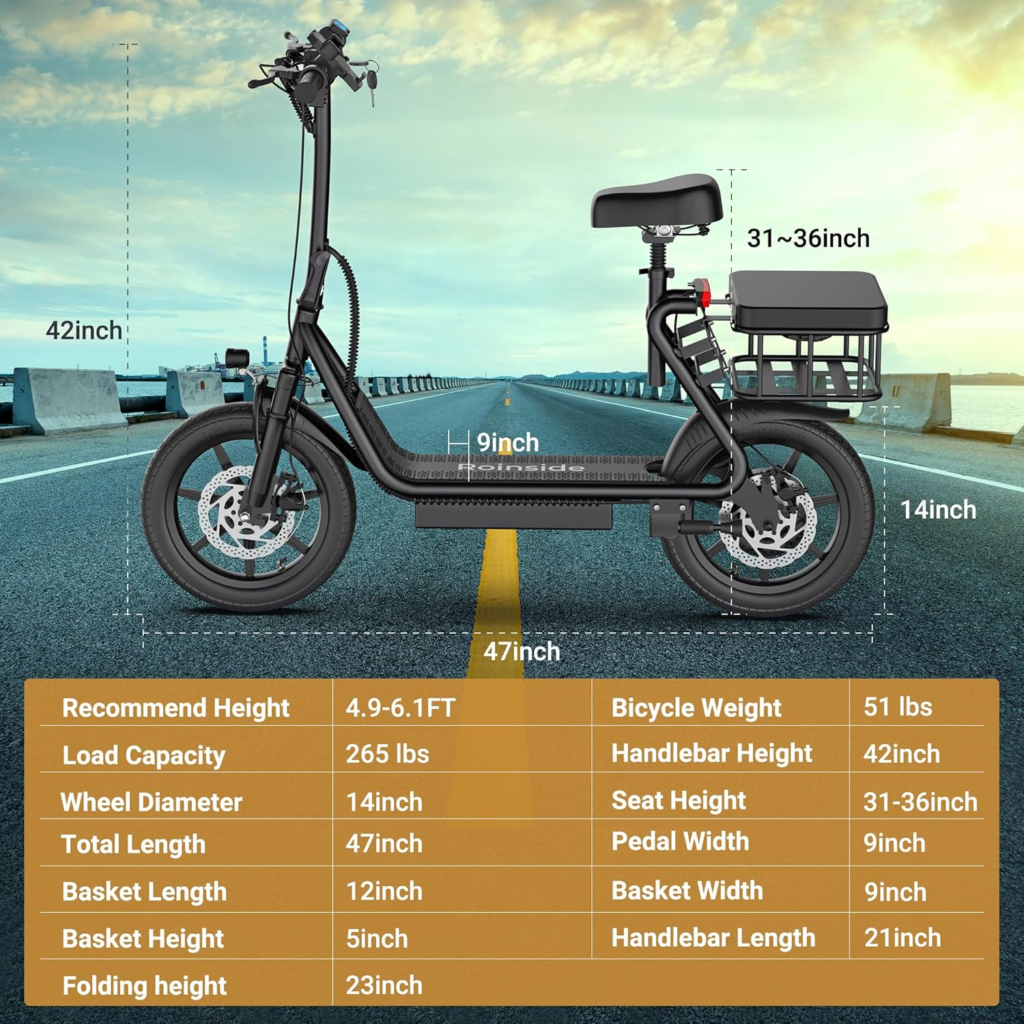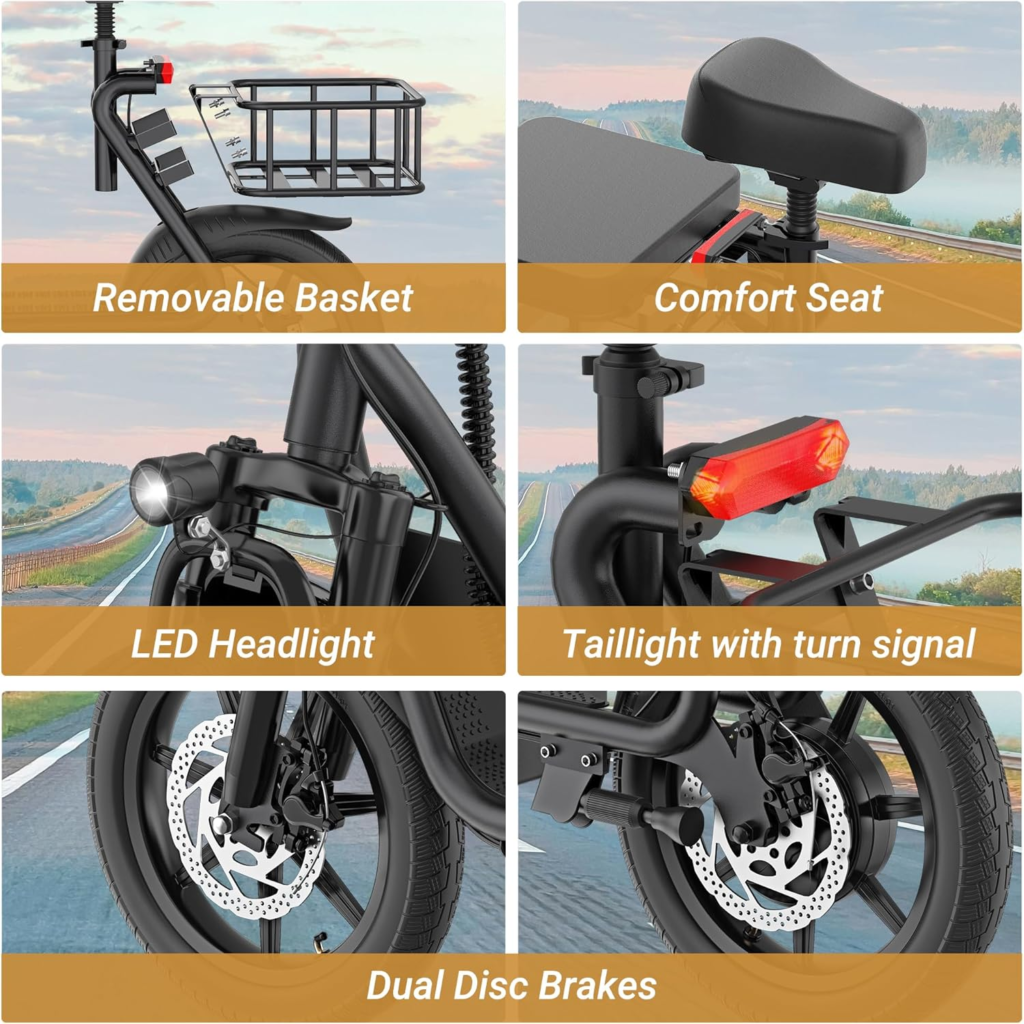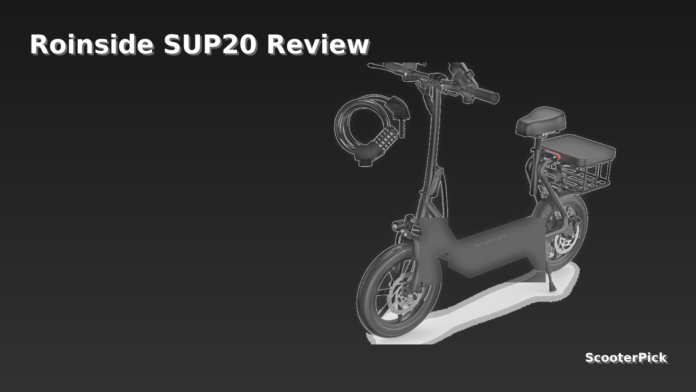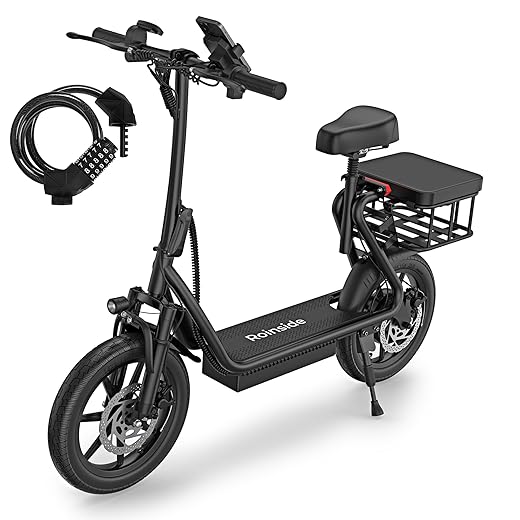The Roinside SUP20 is a different kind of city scooter: a foldable, seated platform on 14-inch pneumatic tires with a 500W hub, a big 48V battery, and commuter-friendly add-ons. This Roinside SUP20 review looks closely at how it rides, how it stops, and how it fits everyday life—using the brand’s official details as the backbone. If you’re eyeing a sit-down commuter that trades tiny wheels for stability, the Roinside SUP20 deserves a serious look.
Key Specifications
The table below consolidates the brand’s official details into quick, skimmable blocks. Figures appear in imperial first, with metric equivalents in parentheses.
General
| Item | Detail |
|---|---|
| Model | Roinside SUP20 |
| Class | Foldable seated electric scooter |
| Intended Use | Urban commuting and short-to-medium trips |
| Rider Capacity | Max 265 lb (120 kg) |
| Seat | Adjustable seat included; foldable frame |
| App / Connectivity | Smartphone app (Bluetooth), speed modes, lock |
| Display | LCD dashboard |
| Water Resistance | Not listed |
Performance & Power
| Item | Detail |
|---|---|
| Motor | 500W brushless hub motor |
| Top Speed | Up to 22 mph (35 km/h) |
| Wheel / Tire | 14 in pneumatic tires (front and rear) |
| Drive Modes | Multiple speed modes (via cockpit/app) |
| Suspension | Rigid (no suspension) |
| Claimed Use Case | Flat to rolling city terrain; seated cruising |
Charging & Electrical
| Item | Detail |
|---|---|
| Battery | 48V 22.5Ah lithium pack (≈ 1,080 Wh) |
| Claimed Range | Up to 62 miles (≈ 100 km) under ideal conditions |
| Charger | Not listed |
| Charge Time | Not listed |
| Protections | BMS protections (general cell safeguards) |
Build & Dimensions (include folded)
| Item | Detail |
|---|---|
| Frame | Aluminum alloy |
| Handle Height | 43 in (109 cm) |
| Unfolded Dimensions | Not listed |
| Folded Dimensions | Not listed |
| Net Weight | Not listed (package: 43 lb / 19.5 kg) |
| Tires | 14 in pneumatic |
Safety & Control
| Item | Detail |
|---|---|
| Brakes | Mechanical disc brakes (listing indicates dual discs) |
| Lighting | Not listed |
| Bell / Horn | Not listed |
| Reflectors | Not listed |
| App Lock | Yes (via app) |
Features & Extras
| Item | Detail |
|---|---|
| Cruise Control | Yes (cruise system via dash/app) |
| Basket | Included rear basket |
| Security | Cable/combination lock included (per box contents) |
| Kickstand | Side kickstand |
| Riding Aids | Speed modes, app-based lock, LCD dashboard |
Warranty & Compliance
| Item | Detail |
|---|---|
| Warranty | 12 months (limited) |
| Electrical Safety | UL2272 certification (scooter) |
| Charger Certification | Not listed |
Design & Build Quality
At first glance, the SUP20 looks more like a pragmatic mini-commuter than a classic stand-up scooter. Crucially, the seat and 14-inch pneumatic tires signal that intent. Because those wheels carry more air volume, they track straighter over seams, shrug off pothole lips better, and keep the chassis calmer at neighborhood speeds. Although the frame is rigid, the tire volume delivers the main comfort layer, which is a smart compromise for mixed urban surfaces.
The frame is aluminum, which resists corrosion and hides everyday scuffs. Moreover, the rear rack carries a basket, so grocery stops and quick errands feel natural. Since the scooter folds, you can stash it in a car trunk or roll it into an elevator; however, it still rides like a compact moped when you’re seated. Consequently, that dual identity—packable yet planted—defines the SUP20’s character and broadens its use cases.
Cable routing is straightforward and avoids snag points. Additionally, the cockpit stays clean: an LCD panel, simple buttons, and levers that are easy to adjust for reach and angle. The overall fit and finish lean toward utility rather than show, which daily riders often prefer. Importantly, check the seatpost clamp at setup. It should lock firmly without grit or slippage. Likewise, inspect the folding latch: you want a positive click and no play at the hinge when locked.

Motor, Power & Acceleration
A 500W brushless hub motor suits a seated commuter well. Rather than chasing explosive launches, it’s tuned for predictable pull and steady cruising. From a stop, the SUP20 eases in, which helps control weight transfer while seated. As a result, the throttle feels calm and precise, so you can meter speed with small wrist inputs in bike lanes and around pedestrians.
In city use, the sweet spot lands around 12–18 mph (19–29 km/h). At those speeds the motor hums, the chassis feels settled, and braking distances stay reasonable. The max of 22 mph (35 km/h) is there when you briefly need to match faster flow. On rolling terrain, the motor copes with gentle grades if you keep cadence up. For longer climbs, choose a middle mode and a steady throttle to avoid heat build-up and to preserve range.
Mode selection genuinely matters. Low tames response for crowded paths. Medium becomes the default for mixed traffic. High works best on open streets with clear sightlines. Because there’s no suspension, smooth throttle progression contributes to comfort; therefore, the motor’s even handoff between modes is a notable plus.
Battery, Range & Efficiency
The battery is the headline: 48V with 22.5Ah capacity, which equals about 1,080 Wh. On paper, that supports a long path. The brand lists up to 62 miles (about 100 km) under ideal conditions. In real use, numbers vary with speed, stops, and hills; nevertheless, the capacity itself sets expectations high. You’ll likely get multiple urban errands or a week of short commutes before you must plug in, especially if you cruise around 12–15 mph (19–24 km/h).
Efficiency improves when you ride smoothly and maintain proper tire pressure. Because the tires are pneumatic, pressure checks pay off quickly. Too low, and rolling drag rises fast. Too high, and chatter increases, which makes you roll off the throttle more often. Consequently, finding the middle yields the best glide. Headwinds and cold weather reduce range, so plan a buffer in shoulder seasons.
The brand doesn’t publish charge rate or time. With a pack this size, expect a multi-hour session from low. Even so, the best practice is to top up when you hit mid-pack rather than deep cycling to empty. That habit reduces cell stress. Additionally, park the scooter in a moderate-temperature room while charging. Batteries prefer calm, not extremes.
Ride Quality, Handling & Comfort
Ride quality is where this platform shines. Because the seat changes your posture and the 14-inch pneumatic tires alter the way the scooter reads the road, the SUP20 delivers a more forgiving feel than small-wheel stand-ups. You sense fewer sharp hits. The chassis tracks straighter over cracks. Moreover, steering remains relaxed instead of twitchy, which reduces fatigue on longer runs.
Since the frame is rigid, tire casing and pressure do most of the suspension work. Start with even pressures front and rear. Then adjust in small steps until chatter fades without introducing wallow. Seated ride height is easy to tune thanks to the adjustable post, and the cockpit layout supports elbows-bent steering—another comfort win. Furthermore, the saddle position lets you modulate weight more naturally during braking and cornering.
At speed, the SUP20 holds a line with little bar input. Stability feels boring in the best way. On broken asphalt, the larger contact patch keeps grip consistent. Therefore, you can pick safer lines and rely on the tires to keep tracking when surfaces vary. For long bike-lane stretches, engage cruise to give your throttle hand a break; the system cancels immediately when you tap the brake.
Braking & Safety Features
Mechanical disc brakes are the right choice for a utility scooter like this. Lever feel is direct and intuitive, so new riders build confidence quickly. The brand’s page calls out dual discs, while a technical blurb uses a generic “rear braking” tag; regardless, the package delivers strong, predictable deceleration without sudden lockups, especially with those 14-inch tires enlarging the contact patch.
On dry pavement, straight-line stops are controlled and drama-free. Over paint lines or in light rain, begin your stop earlier, keep the bike upright, and squeeze smoothly. Because you’re seated, forward weight transfer is milder than on a stand-up scooter, so the rear brake stays more effective. Consequently, the scooter tracks straight and learning time shortens for new riders.
Lighting isn’t detailed in the sheet, so plan to add a helmet light or a small bar-mounted lamp if you ride after dusk. Additionally, reflective tape on the basket and rear rack helps at intersections. The app lock is a useful deterrent for quick errands; however, a real U-lock or sturdy chain remains wise for longer stops.

Portability & Daily Usability
The SUP20 folds, yet it isn’t a featherweight. The large tires and seat make it more “carryable” than “tote-able.” Even so, the fold is practical for apartment storage, office corners, and car trunks. The hinge closes with a solid click, and the folded stance is compact enough to maneuver through standard hallways and doorways.
Daily living perks are the quiet heroes here. The basket saves a backpack. The seat reduces fatigue during long, slow bike-lane queues. Meanwhile, the bigger tires float over brick seams and utility trench patches. Kickstand deployment is easy, so curbside stops feel natural. Because the scooter sits taller than tiny-wheel commuters, visibility in traffic improves; therefore, you feel more seen, which reduces stress.
One note on stairs and train platforms: plan your carry grip before you leave. The most balanced lift is usually one hand on the stem and the other bracing under the rack. Take one flight at a time and set it down gently to protect the latch. Additionally, practice the fold-and-roll move at home so station transitions are smoother.
Features, App & Extras
The SUP20’s app is straightforward. It pairs quickly, lets you choose speed modes, and enables the lock function. Cruise control is available and behaves as expected: hold a steady speed for several seconds to set it, then cancel with any brake input. The LCD dashboard reads clearly in daylight. You get the essentials: speed, battery level, and mode. For many riders, that’s all they need.
Additionally, if you’re comparing seated formats across the lineup, take a quick look at the Roinside electric scooter product page for context on the platform.
Included accessories make first-week ownership easier. A basket makes grocery runs simple. An included lock helps with brief errands, though you’ll still want a heavier option for real security. The charger is compact and fits in a backpack if you need to top up at work. Likewise, small touches such as a solid kickstand and sensible fenders round out the package.
Because the water rating isn’t listed, treat heavy rain as a no-go. Light mist or a quick sprinkle on the way home is one thing; sustained wet rides are quite another. If you do get caught out, wipe the scooter dry—especially around the hinge, seatpost clamp, and connectors—and let it air before the next ride.
Charging Experience & Maintenance
Charging should feel invisible: plug in after dinner, ride in the morning. With a pack this size, it’s worth charging before you hit the bottom third. That habit avoids deep cycles and stretches battery health. Also, keep the charger on a firm, ventilated surface. Coiling cables neatly and avoiding strain at the barrel connectors will help them last.
Maintenance is simple and periodic. Set a monthly reminder to check tire pressure and bolt torque at the stem, rack, and brake calipers. Cable-pull disc brakes bed in over the first few rides; after that, lever feel should stay consistent. If a pad begins to rub, center the caliper and reset cable slack. Additionally, if your commute includes grit and dust, wipe the seatpost stanchion and re-lube the clamp cam now and then. That keeps creaks away and height changes smooth.
The folding hinge appreciates attention as well. Keep it clean and dry, and add a drop of dry lube to the latch contact points if you notice stickiness. Do not use heavy oil near the latch—it attracts dust. Instead, use a light, dry formulation and cycle the latch a few times to distribute it.
Testing Notes — Roinside SUP20 review Method
To keep this evaluation relevant for commuters, the scoring emphasizes controllability, stability at neighborhood speeds, hill behavior on modest grades, and ease of living with the seat and basket day to day. We also weight braking feel and predictability on mixed surfaces, because those factors drive confidence more than headline speeds. Range commentary assumes varied urban riding rather than lab loops, and tire pressure is set in the middle of the recommended window.

Who the Roinside SUP20 Is For
Choose the SUP20 if you want a seated city scooter that prizes calm handling and long stints between charges. It suits riders who cover several miles of bike lanes daily, carry a small load, and prefer a stable feel over a compact, stand-up footprint. New riders will appreciate the predictable throttle map and the easygoing steering. Additionally, taller riders will like the seatpost’s range and the relaxed elbows-bent cockpit.
If you live at the top of a steep hill, plan for reduced speed on climbs or consider a higher-power class. If your commute involves lots of stairs or frequent lifting, a smaller-wheeled, lighter scooter may fit better. Nevertheless, for most flat-to-gently-rolling routes, the SUP20’s big tires and battery make everyday rides simple and low-stress.
Value for Money & Verdict
In this Roinside SUP20 review, we judge value by how little drama you have after week two. The SUP20’s package—14-inch pneumatics, seated posture, 500W hub, and a 48V pack—tilts the odds in your favor. The included basket and lock reduce the “what else do I need?” list to a good helmet and a brighter front light. Meanwhile, the app lock and cruise control round out the core features without adding complexity.
Verdict: if your commute is more about rolling, steady miles than stoplight sprints, this seated, large-wheel format feels right. It’s easy to live with, planted at speed, and forgiving on rough patches. Confirm your storage plan and charging routine, set tire pressures carefully, and enjoy a calmer kind of city ride.
Pros & Cons
Pros
- Big 48V 22.5Ah pack supports long urban rides
- 14-inch pneumatic tires improve stability and comfort
- Seated posture reduces fatigue on longer bike-lane stretches
- Predictable 500W hub with friendly throttle mapping
- App lock, cruise control, and simple speed modes
- Foldable frame with practical basket for errands
- UL2272 electrical certification and a clear LCD dash
Cons
- Lighting details not published; riders may want an add-on headlamp
- Rigid frame means tire pressure does most comfort work
- Heavier and bulkier than tiny-wheel commuters when folded
- Water resistance rating not listed; avoid sustained wet rides
- Charger specs and charge time not provided
- Brake language is inconsistent across blurb sections; verify dual-disc hardware
Price
FAQs
Does the Roinside SUP20 have cruise control?
Yes. Hold a steady speed for a few seconds to set cruise, then tap either brake to cancel immediately.
What real-world range can I expect from the 48V 22.5Ah battery?
Expect less than the ideal 62 miles (≈100 km) if you ride fast, stop often, or face hills. Smooth, moderate speeds deliver the best results.
Can I ride the SUP20 in the rain?
The brand doesn’t publish a water rating. Treat heavy rain as off-limits. If you get caught in a sprinkle, wipe the scooter dry and let it air.
How fast does it go, and is that speed stable?
Top speed is up to 22 mph (35 km/h). The 14-inch pneumatics help it track straight at neighborhood speeds, which keeps the ride calm.
What maintenance should I plan for?
Perform monthly checks on tire pressure and bolt torque, plus occasional brake cable adjustments. Keep the hinge and seatpost clamp clean and lightly lubricated.
Is the SUP20 good for carrying groceries or a laptop?
Yes. The included basket suits small loads, and the seated posture keeps the scooter stable while you carry them.



